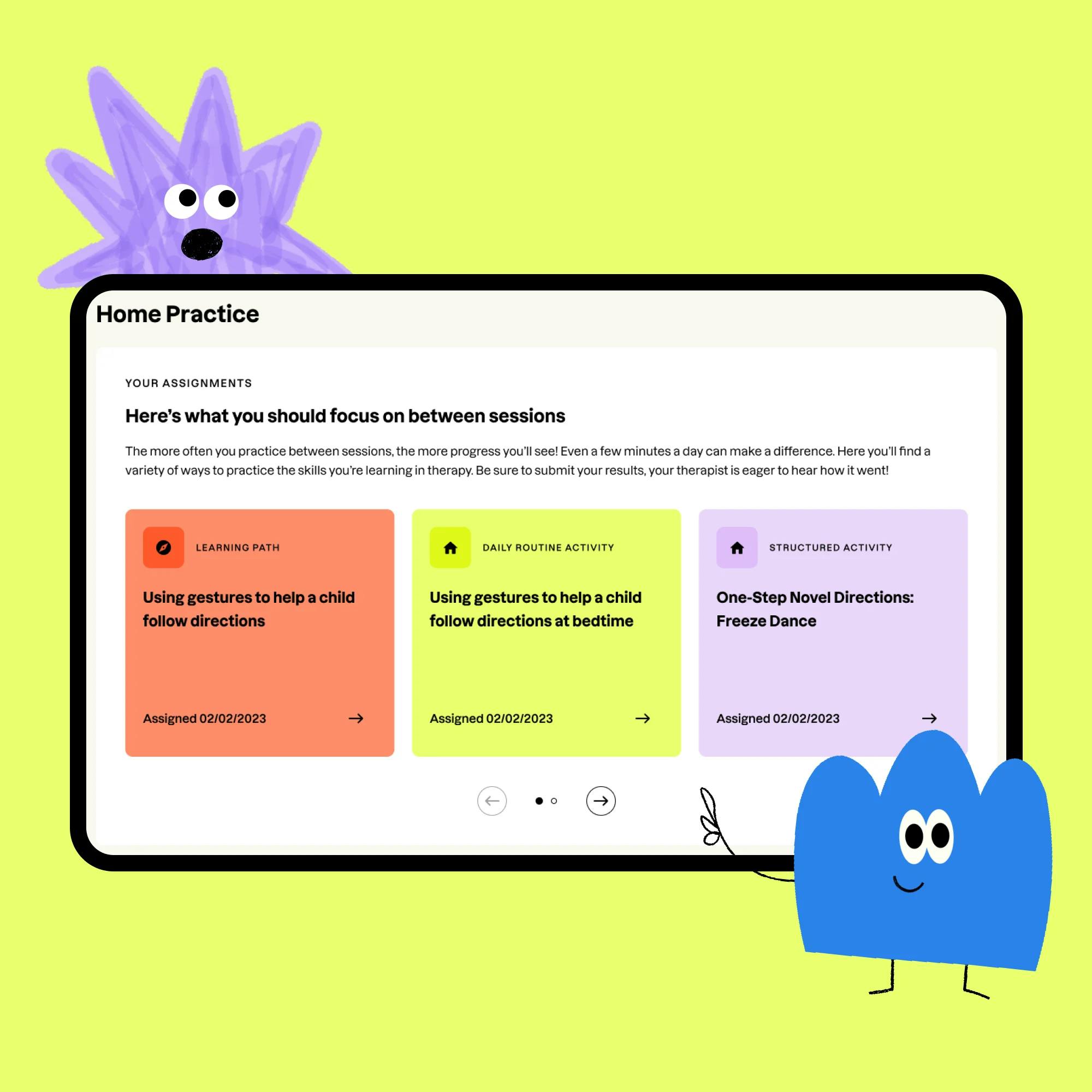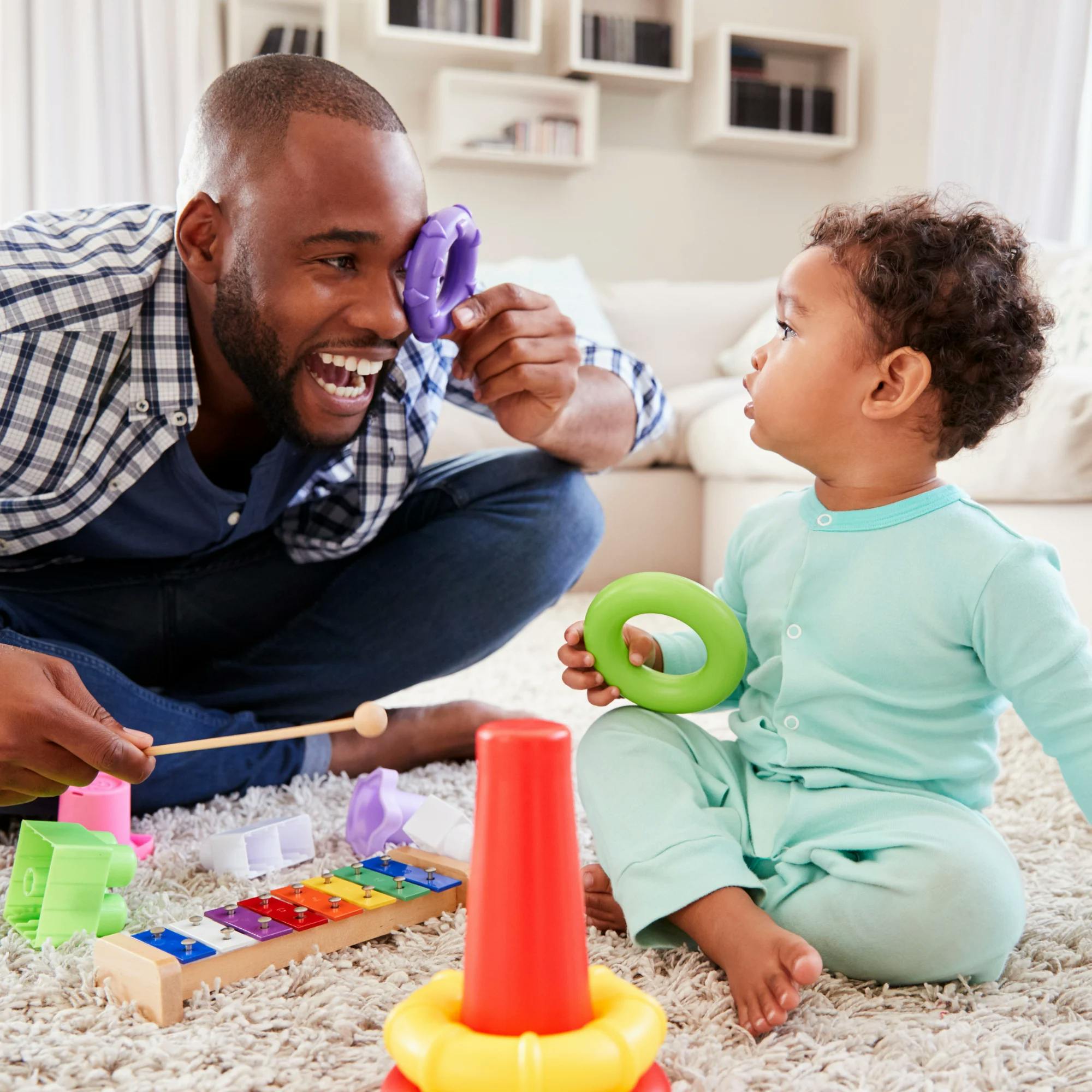Some children easily learn how to use language to communicate. But for others, the process of language development isn’t so simple. Children with a receptive language disorder may have difficulty understanding what other people are saying. Those with an expressive language disorder may have a hard time expressing their thoughts, ideas, and feelings.
As a parent, this can be disheartening to watch. You may wonder, “Will my child grow out of it?” or “How do I know if they need speech therapy?” You may worry that your child’s language problems will affect them emotionally or in school.
Here at Expressable, we’ve worked with thousands of children with expressive, receptive, and mixed language disorders. We created this informational guide to answer your questions about the causes and signs of a language disorder, how language disorders are treated, and how parents can help their child at home.
Curious or concerned?
Our free screener is tailored by age and covers all areas of speech, language, and feeding. Find out if your child might need speech therapy.
 Screener for children
Screener for childrenWhat is a language disorder?
A language disorder is a type of communication disorder that makes it difficult to use, process, and comprehend language. Children with language disorders might have trouble understanding what other people are saying or expressing their own needs and feelings.
While many people associate language with talking, language can take a variety of forms. It can be related to the words we use, our reading and writing ability, the ability to form sentences, the use of gestures, and conversational skills.
Note: You may sometimes hear a language disorder referred to as a speech delay. “Speech delay” is a common term that many parents and caregivers are familiar with. It generally refers to a delay in speaking, but it isn’t a formal diagnosis used by speech therapists.


What are the two types of language disorders?
There are two main types of language disorders. Understanding their differences is vital to getting your child the help they need.
Expressive language disorder: Children with an expressive language disorder might struggle with using new vocabulary, organizing words into a sentence, retelling stories, or using words to express their wants and needs. An expressive language disorder can be frustrating for children--they know what they want to say, but they can’t produce clear sentences when they talk.
Receptive language disorder: Children with a receptive language disorder have difficulty understanding and getting meaning from words they hear. They may have trouble grasping what others are saying, or interpreting written words. As a result, they may struggle to respond to questions, or they may respond in a way that doesn’t make sense.
In some cases, children have a mix of both expressive and receptive language issues. These children have trouble both using and understanding language. This is classified as having a mixed language disorder, also known as a mixed expressive-receptive language disorder.

What is the difference between a speech sound disorder and a language disorder?
Language disorders are commonly confused with speech sound disorders. However, they aren’t the same. While the differences can seem small, it’s important to understand which your child is experiencing. “Speech” refers to how we say different sounds and words. For example, stuttering is a common speech disorder. So is having trouble pronouncing the letter “r” or the sound “sh.” “Language” refers to how we use and understand words to get our message across.
“Speech” refers to how we say sounds and words. “Language” refers to how we use and understand words to get our message across.
Let’s look at an example of two children, John and Sarah. John has trouble articulating speech sounds. He says “thith” instead of “this,” and “wadio” instead of “radio.” He uses words and phrases to express his ideas, but he has trouble forming the correct sounds for clear speech. Sarah, in contrast, has trouble stringing together the right words to form clear sentences. She wants to say “Can we go to the park, please?” but instead says “I go park, please.” She pronounces the words correctly, but she can’t form phrases or sentences that make sense. In this example, John has a speech sound disorder, and Sarah has an expressive language disorder. Both of their families may have trouble understanding them, but for completely different reasons.

What are the signs of a language disorder?
A language disorder is often present in children from an early age. However, the symptoms may not be noticed until the child is older and begins to use more complex language. The signs and symptoms of a language disorder can vary depending on whether a child has a receptive or expressive language disorder. If you notice any of the signs below, talk with your child’s pediatrician or a speech-language pathologist, also known as a speech therapist.
Signs of a receptive language disorder
Children with a receptive language disorder may have trouble:
Understanding and processing what people say
Reading and learning new vocabulary words
Comprehending new concepts or ideas
Following directions and organizing their thoughts
Toddlers should be able to follow one-step directions by the time they’re 18 months old. An example might be "Come sit at the table.” By age 30 months, your child should be responding to questions or directions with words or gestures, such as a nod or head shake. If your child hasn’t reached this milestone, it may be a sign of a language disorder.
Signs of an expressive language disorder
Children with an expressive language disorder may have trouble:
Using words to communicate
Using words and sentences correctly; they may leave out words from sentences, confuse word tenses, repeat words out of order, or use placeholders like “um” or “uh” when speaking
Telling stories or having a conversation
Asking questions or expressing their needs
Singing songs or reciting poems
Many of these symptoms can be a natural part of language development. However, if these issues don’t improve over time, it’s important to talk with a speech therapist.

How common are language disorders?
In the United States, between 6 and 8 million people have some form of language impairment. According to the National Institutes of Health, approximately 3.3% of children between the ages of 3 and 17 have had a language disorder during the past 12 months.
What causes language disorders in children?
Language disorders can have many causes. They are often caused by a health problem or disability. If any of these factors apply to your child, they may be at a higher risk for language problems:
Pregnancy complications, such as premature birth, low birth weight, poor nutrition, or fetal alcohol syndrome
A developmental condition such as autism
A brain injury such as a tumor
Birth defects such as Down syndrome, fragile X syndrome, or cerebral palsy
In many cases, genetics may play a role. Children with a family history of language problems may be at a higher risk.
Expert language support
If your child has trouble expressing themselves or understanding others, a speech evaluation may be helpful. Take the next step today.
 Find a speech therapist
Find a speech therapistHow can language disorders affect a child's everyday life?
Being able to communicate clearly is one of life’s most valuable skills. Language plays a key role in learning to read and write, interacting with other people, and having a successful career. Language disorders can cause major problems if not properly treated. Children may have trouble in school and receive poor grades. They may have low self-esteem and find it hard to make friends. They may have behavioral problems because of their frustration with communicating. As with most developmental issues, the best treatment is often early intervention. In fact, research suggests that the first 6 months of a child's life are the most critical to their language development. So, treatment for language problems should start as early as possible.


How are language disorders diagnosed?
If you are concerned about your child’s language development, tell your child’s doctor. Your pediatrician will start by observing your child’s language and asking questions about your family history. Most likely, they’ll also test your child for a hearing impairment. Hearing problems can lead to language difficulties. In many cases, your doctor will refer you to a specialist called a speech-language pathologist, or speech therapist. They are the most qualified professionals to evaluate, diagnose, and treat language disorders. When choosing a speech therapist, look for someone who is both accredited and experienced in dealing with language issues. To diagnose a language disorder, your speech therapist will conduct an evaluation to test your child's ability to both understand and express language. They’ll evaluate how well your child performs age-appropriate communication tasks, assessing their:
Vocabulary
Sentence structure
Ability to listen and follow directions
Ability to hold a conversation and answer questions
Other aspects of language as needed


How are language disorders treated?
Treatment for language disorders will largely depend on your child’s age and the cause and extent of their condition. Your speech therapist will start by identifying your child’s areas of strength and weakness. They will develop a tailored treatment plan to help your child grow their language skills and communicate more clearly. This will also help set the foundation for your child’s reading and writing skills. Keep in mind, depending on your child’s language disorder, their care team may also include teachers, mentors, audiologists, behavioral therapists, and more. In speech therapy for a language disorder, your speech therapist may do the following activities with your child:
Help your child learn to relax and enjoy communicating through play
Use toys, games, books, objects, or pictures to help with language development
Have your child do educational activities or worksheets
Have your child practice asking and answering questions
Other strategies used in speech therapy for expressive and receptive language disorders might include communication temptations, offering choices, language expansion, recasting, and wait time. At Expressable, all families have access to our client portal, which features educational Learning Paths with tips and videos related to what your child is learning in therapy. Plus, through the portal, families receive weekly home practice activities tailored to their child's needs. The more often you practice speech therapy techniques at home, between sessions, the faster your child will make progress! We built our whole care model, including our client portal, to make it easier for families to do just that.
You can learn more about Expressable's clinical approach to evaluating and treating language disorders in our treatment guide.


How does online speech therapy work for language disorders?
Expressable matches families with a licensed speech therapist trained to evaluate and treat expressive, receptive, and mixed language disorders. All therapy is delivered online via face-to-face video conferencing on Zoom. Online speech therapy makes it easier for parents and caregivers to be involved, and parent coaching is a key part of our treatment for language disorders. Your child’s age and development will influence how your speech therapist interacts with them and you during sessions:
Ages 0-3: Caregivers attend sessions and work directly with their child's speech therapist to learn cues and at-home strategies. This way they can confidently practice with their child throughout the week and help their child make progress. Ages 3-6: Caregivers attend video sessions alongside their child so they both learn valuable skills from their speech therapist. Reinforcing these lessons outside the session will continue to promote skill-building. Ages 7 and up: Most children attend video sessions independently, but parents are kept in the loop with updates and tips during each session.


How can I help my child with their language disorder at home?
No one knows your child better than you: their needs, their personality, how they learn, and what's challenging for them. You’re with your child every day, and there are lots of opportunities to practice and reinforce the skills they’re learning in speech therapy. Here are some helpful tips and recommendations to help your child with their language skills at home:
Speak clearly with your child. It’s important for families to model clear, slow, and simple language at home. In addition, try not to answer questions for your child if they’re taking a long time to respond. Give them time and space to gather their thoughts.
Practice language during everyday routines. Children learn to use language by listening to and speaking with others. And who spends more time with your child than you? Overcoming a language disorder takes time and persistence, but research shows that when caregivers are actively involved in their child’s therapy, they make better progress. There are lots of easy ways to practice during daily routines like bathtime, mealtime, and commuting.
Ask for accommodations at school: If your child is in school, get to know their teacher and the school staff. Ask about any accommodations that can help your child in the classroom. It might help for the teacher to provide one-on-one attention and simpler instructions, encourage your child to interact with their classmates, or ask your child to repeat back directions to ensure they fully understand. Your child may also qualify for an Individualized Education Plan (IEP) to support them in school. Your speech therapist can help you with these discussions.
Your speech therapist will tell you exactly how to practice with your child at home. But here are a few more activities that can help improve language skills:
You'll find more at-home speech therapy strategies in our video collection on YouTube.
Contact Expressable today
If you’re concerned about your child’s language development, we’re here to help. We’ll match you with a licensed speech therapist who can evaluate your child and guide you on the right next steps. Start our simple sign-up here!
How Expressable Can Help
Concerned your child isn't reaching age-expected milestones? Looking for communication support from a professional? Expressable is a national online speech therapy practice serving children and adults. We treat all major areas of communication and feeding, offer flexible hours including evenings and weekends, and accept most major health insurance plans. We’re proud to have earned more than 3,000 5-star reviews from our clients (4.9/5 average).
Our therapy model is centered on parent and caregiver involvement. Research proves that empowering caregivers to participate in their loved one’s therapy leads to better outcomes. That’s why we combine live, 1-on-1 speech therapy with personalized education and home practice activities for faster progress.
Communication is more than words. It’s how we share how we feel and show who we are. We’re here to help you or your child do just that.

 Abby Barnes, M.S., CCC-SLP
Abby Barnes, M.S., CCC-SLP









